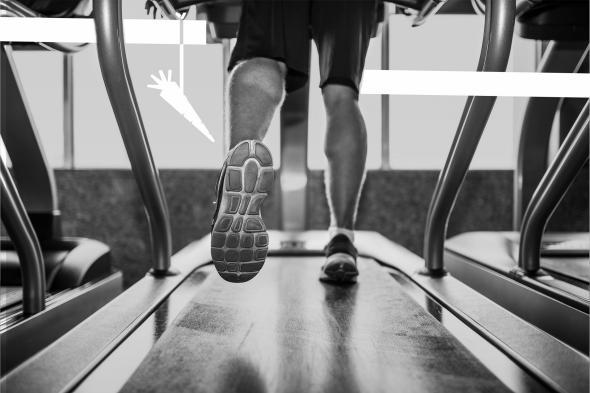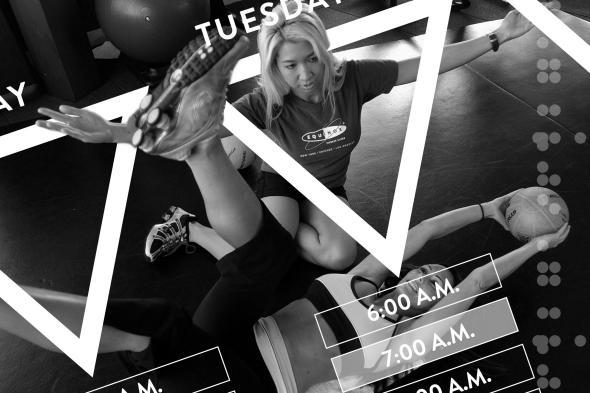This article was reported in partnership with the Investigative Fund at the Nation Institute.
In the big business of upscale gyms, Equinox soars above its rivals. With Kiehl’s hair and body products in the locker rooms and “eco-chic amenities” such as sustainable cork floors, Equinox promises epic workouts and unexpected luxuries to a clientele primarily of coastal elites. And at the heart of its product is a small army of “science-fueled” personal trainers.
Philip Levi, who worked at an Equinox in Silicon Valley from 2009 to 2014, used to be one of them. A loquacious Tennessee native with a boyish grin and hemp-rope abs, Levi has an elaborate back tattoo of da Vinci’s Vitruvian Man, surrounded by an interplanetary dreamscape that suggests a clandestine wild side. One day in 2010, Levi learned that of the more than 1,800 personal trainers then working for Equinox’s 56 clubs in the U.S. and Canada (it now has 83), he ranked No. 9. As a “master instructor” who mentored less experienced trainers, he had finally garnered recognition for his teaching ability—the time and attention he offered his clients and the dramatic progress they made. Or so he thought. When he asked how Equinox arrived at its ranking, he was told, “It’s how many sessions you’ve done.”
No wonder, Levi says, “I was fricking miserable.”
At the time, Levi was in his mid-20s and considered himself a training “superstar.” “I trained between five and eight clients every day, five or six days a week plus two or three on Saturday and three group fitness classes a week,” he says. “I was up before the sun and [went] to bed late.”
Levi, now 31, had stretched himself as thin as he possibly could at his job while still maintaining his sanity and some semblance of a personal life. He says the most he ever made in a single month was $7,000, and that was “before taxes, on a very, very busy month.” He had convinced himself that only such martyrish dedication could lift him to the top of his profession. Now he had reached the mountaintop and gazed out at the horizon—and found he didn’t much like the view.

Photo illustration by Natalie Matthews-Ramo. Photo by Dina Rudick/the Boston Globe via Getty Images.
National surveys consistently show that the nation’s top two New Year’s resolutions are to lose weight and exercise more. So every January, health club memberships spike, with new memberships doubling at many gyms. Studies show that roughly half of us who start a new exercise program will drop out within six months. For some of us who stay committed, our relationship with our personal trainer is key—even if it’s also a righteous splurge, like a $10 green smoothie. But what’s it like for the trainer pushing you through that one more set?
At the Equinox in San Mateo, California, Levi cultivated a warm rapport with his wealthy clientele: housewives able to afford “an arm and a leg” in membership fees, top managers at tech firms. He recalls one Silicon Valley vice president who appreciated just talking about movies, being treated like “a dude.” As Levi used to tell clients, “You’re going to pay a lot, but you’re going to get a lot, too.”
As a Tier 3+ trainer hitting his Equinox session targets, Levi got a payout of around $45 per session, he recalls, far more than Tier 1s, who got around $20. (For downtime between sessions, which he used for planning, he was paid minimum wage.) He had a good health plan with dental insurance. Yet even maintaining that stressful pace—which he knew he couldn’t—he rarely brought home more than $50,000 a year, while his lower-tier co-workers would earn far less. Whenever a regular client took a vacation to Tahoe or a business trip to Kuala Lumpur, Levi took a hit to his take-home pay. (Asked about Levi’s account, Equinox declined to comment, citing a policy of not speaking about personnel matters.)
Health clubs have become a $24 billion industry in the U.S. Yet according to 2014 figures from the U.S. Bureau of Labor Statistics, median pay for fitness trainers is quite low—$34,980 a year, well below the median household income of $53,657. According to a 2010 national survey by the American Council on Exercise, nearly half of all personal trainers work as independent contractors, though a majority are employees. The BLS puts the share of independent contractors far lower, at 10 percent. But even personal trainers who are technically gym employees may not experience the conditions that employees in other industries value. While working for the “big box gyms” like Equinox or Bally Total Fitness, Levi explains, “You are an employee of the company, but the meat and potatoes of it is that you’re operating in the manner of an independent contractor, you just have a company taking a percentage.” Fitness chains often hire trainers at an hourly rate—typically at or close to minimum wage—which is supplemented by a system of commissions on each training session, with rates that escalate with experience. While clients pay an average of $60 to $70 per hour, according to the National Board of Fitness Educators, on average trainers receive only $25—less than half. (Of course, the cost to clients for the most experienced trainers can top $100 an hour—and an elite Tier 4 trainer at Equinox might make $60 or more of that.) In between sessions, while helping restock towels or handle paperwork, few trainers earn more than the hourly base pay. And, Levi says, rising fees to clients for training sessions don’t always mean rising compensation for the trainers themselves.
Despite the long hours and mediocre pay, the BLS expects the number of personal trainers to grow by 8 percent over the next decade. Yoga in particular has become big business. A Yoga Journal survey reported that between 2008 and 2012, the number of Americans who said that they were interested in doing yoga rose from 18.3 million to 104.4 million. Which, though it doesn’t mean they’ll ever get off the couch, apparently counts for something.

Photo illustration by Natalie Matthews-Ramo. Photo by Thinkstock.
Elizabeth, 33, who worked as a personal trainer at a Bally in midtown Manhattan at around the same time as Levi broke the top 10 at Equinox, describes the employment environment at some large gyms as “a little bit of the Wild West.” At Bally, says Elizabeth, who asked that her last name not be used because she continues to work as a trainer in other gyms in Brooklyn and Manhattan, the focus was squarely on bagging new customers. “You have a quota you have to reach”—for signing up new clients—“and a certain amount has to be new sales.” Sales of personal training sessions were a bigger cash cow than new memberships, she says they were told, as “re-signed contracts didn’t really contribute to ‘growth.’ ” Promotions inside and outside the gym would encourage members and nonmembers alike to sign up for free consultations with trainers, and trainers were also encouraged to approach members who were struggling to bench press or fumbling with treadmill controls in order to pitch their services.
Such quotas are common for trainers. A recent job posting for a trainer at 24 Hour Fitness—which recently bought up 32 Bally facilities across the country—lists meeting or exceeding “session service targets” as part of the job description. (“Extended workdays are a frequent occurrence,” it also notes, “as are weekends and holidays.”) Elizabeth says the quotas created a competitive environment among the trainers, until what started out as a training job became, in reality, a sales job. (24 Hour Fitness declined to comment on employment-related matters, citing concerns over confidentiality.)
“There was not a lot of regulation,” Elizabeth dryly reports. Sometimes it seemed that anyone who had ever even strolled past a gym could pop inside and get hired. “I walked into Bally with zero certification and got a job,” she says. When she resisted taking on clients right away, a manager threatened to fire her. “You could pretty much take an online test and have a certification,” she says. “You could train people for months without a certification. There was no emphasis whatsoever on skill—the more clients you brought in, the more money you brought in. It’s a hustle.”

Photo illustration by Natalie Matthews-Ramo. Photos by Thinkstock.
The 24 Hour Fitness ad notes, “Personal Trainer experience preferred but not required.” And among the certifications it accepts are one that can be obtained by means of a multiple-choice exam.
An affable guy with the profile of an action hero and a cleft chin that could sharpen a knife, Paul Jacobi, 34, would probably find that characterization exaggerated. “Any gym that hires trainers as employees—not independent contractors—[is] going to have sales quotas,” says Jacobi, a trainer at a Manhattan branch of Crunch Fitness. “My quota is $2,000 a month in personal training sales and $200 a month in supplement sales.” Yes, Jacobi must sell products like multivitamins, preworkout shakes, and whey protein made by California-based fitness supplement maker dotFIT, a company that distributes its wares through trainer recommendations. This doesn’t trouble him. “Personally, I have never come close to missing a quota. From my observation, the trainers that consistently miss the quota are lazy and do not try. While sales is part of the job, our culture is to provide a great service and help clients reach their goals.”
Still, while many gyms shunt the responsibility for signing up clients to their trainers, they typically take “at least half” of the fee charged to the customer, according to Elizabeth, an estimate backed up by national data. “My average take home was like $32 [per session], and Bally was getting about $60,” she says.
Unlike Levi’s job at Equinox, Elizabeth’s gig at Bally didn’t provide comprehensive health benefits, which is common in the industry. According to the American Council on Exercise survey, only 43 percent of full-time trainers have full health coverage, and only 4 percent of part-timers do. “The system was really terrible,” Elizabeth says. (Bally, once a national fitness powerhouse with more than 400 gyms that now operations just three locations, did not respond to calls or emails requesting comment.)
Fitness workers face a range of occupational injuries, according the federal Bureau of Labor Statistics, including sprains, tears, cuts, and bone fractures. And both Bally and 24 Hour Fitness have racked up numerous health and safety citations over the past 10 years, according to the Occupational Safety and Health Administration.
A structure existed at Bally through which you could get comprehensive health insurance, Elizabeth says, but it relied on a quota system as well. She recalls that trainers had to average 35 sessions a week for three consecutive months to earn the coverage, and if they went on vacation or took sick days at any time during the three months, they lost out. Elizabeth recalled one co-worker, a parent, who got kicked off the health plan because one week, a few of his clients left town and he missed his mark. Despite her efforts to get other people in shape, Elizabeth couldn’t guarantee her own wellness. “We often had to work sick in order to keep our hours up [for] fear of losing benefits or incentives,” she says.
“There was a lot of fighting about money,” she says of Bally. “They were under massive pressure to meet budget.”
In the past decade, trainers and other gym employees have filed multiple labor suits against nearly all of the major fitness operators—among them 24 Hour Fitness, Equinox, and Crunch—many of which center around squeezing costs. Among the most common labor violations of these chains, according to three lawyers who have leveled class-action suits against them, are misclassifying workers as management in order to exempt them from federal rules covering overtime pay. In addition, explains Scott Cole, an attorney who has litigated against Crunch, Equinox and 24 Hour Fitness, “we see instructors not being reimbursed for expenses they incur” and “instructors working off the clock.” “They are not paid for putting together a CD [to play during sessions], for meetings, for time spent before and after class talking to club clients,” he says. “They aren’t paid for the marketing. These aren’t one-off cases. It’s pretty standard practice at those gyms.” In one case against 24 Hour Fitness, 862 plaintiffs alleged that managers required them to work off the clock and failed to compensate them for overtime. 24 Hour Fitness had been sued so much that it introduced a clause in its employment contracts forcing employees to go through arbitration, rather than the courts, with any employment-related claims. The National Labor Relations Board struck the policy down as violating federal labor law.

Photo illustration by Natalie Matthews-Ramo. Photo by Richard Hartog/Los Angeles Times via Getty Images.
In the case of Bally—many of whose former locations are now 24 Hour Fitness gyms—trainers and instructors who were not full-time employees had to clock out between sessions, according to Elizabeth. Or they’d get paid minimum wage to cover administrative and maintenance tasks. Generally, the minimal training required of new hires tends to mitigate against the culture changing too quickly. A lot of trainers are “your big dudes who used to be football players who aren’t that smart doing a job that almost anyone can do,” according to Elizabeth, so it’s difficult for them to envision the system working in a different, potentially more functional way.
Few choices are available to trainers who find themselves unhappy in dangerous and dysfunctional workplaces, especially since many only have high school diplomas or associate’s degrees: They can quit, stay and fight (while risking getting fired), or suck it up and deal. In the immortal words of many a fitness instructor, no pain, no gain. Convinced that better times await, they may dream of going independent, as Levi did after leaving Equinox.
“You got golden handcuffs,” he says. “Everything was shiny and clean and sterilized, but you’re under that roof, and you’re their employee. Every good trainer goes private at some point.”
But building a private clientele can be a more daunting prospect than it first seems. Many big box gyms seek to quash any potential competition from their former employees, so they require trainers to sign “noncompetes,” clauses in their employment contracts that prevent employees from working as independent trainers within, for example, 10 miles of one of their gyms. “They clip your wings,” Levi says.
Savvy trainers often try to get around these stipulations by referring to themselves as teachers or motivational experts or bloggers until the noncompetes expire. “You don’t want a big box to come after you,” says Levi. “So you get stuck between a rock and a hard place.”
Some trainers settle for those golden handcuffs, of course. By remaining at a big box gym, you’re more immune to fluctuations in the economy. “If there’s a financial crisis, there will always be the membership to draw from,” says Levi. “But if you go out on your own, it’s a big scary world out there.”
The question is, how long can you last putting in long physical days, every day of the week? “No judgments” is Crunch’s motto, a credo once lettered all over its walls and mirrors, intended to make out-of-shape or older folks feel welcome. But in reality, gym culture promotes youth. There’s almost always high-energy dance music on the P.A. system, and that dance music is always up to date. The nightclub atmosphere of many higher-end gyms affects the trainers too. Many trainers, Levi says, “are still living like they are in college and they still have their youth, but we as human beings have an expiration date.” Elizabeth’s aunt, a former dancer, is still a personal trainer in her 60s, but that seems just short of miraculous. And if you’re only earning $35,000 a year and paying for your own health care, you’ll be pushing people through squats a lot longer than that.
The Grind is a yearlong series looking at the unsavory—and often hidden—working conditions behind some of our cherished annual traditions. It is a collaboration with the Investigative Fund at the Nation Institute, a nonprofit journalism center. Ava Kofman provided research assistance for this article.
